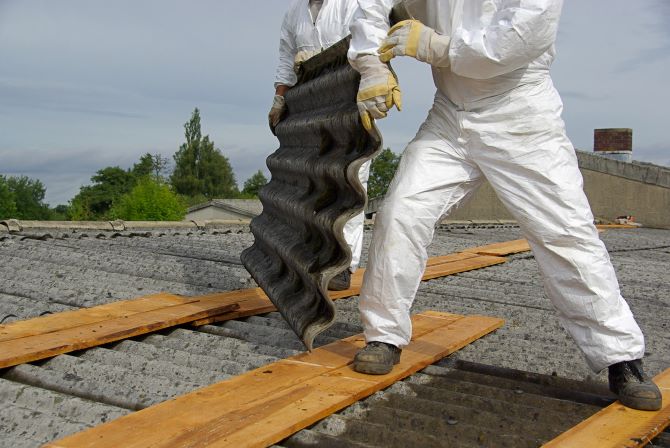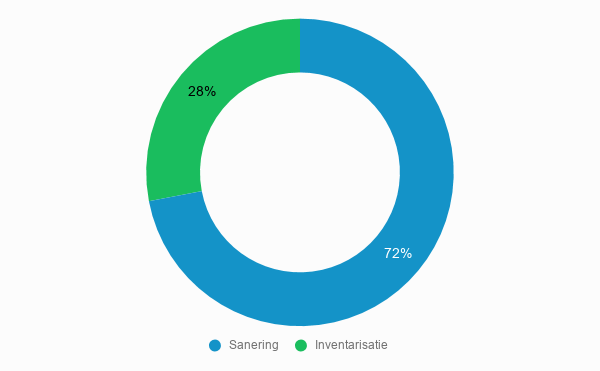Remediating asbestos is a project that carries health risks. That is why it is best to hire a specialist in the field. Are you curious about asbestos remediation costs? This article will tell you all about it.
What does asbestos removal cost?
The asbestos removal costs start around £1,000 for an entire room. Asbestos removal of corrugated sheets is slightly cheaper, with most prices starting at around £600. View the overview below for average asbestos removal costs.
| Project | Costs, incl. VAT |
|---|---|
| Asbestos inventory (for residential property) | |
| – Inventory of visible material | £ 300 – £ 500 |
| – Full inventory | from £ 450 |
| Asbestos removal | |
| – Corrugated sheets 1 – 10 m2 | £ 600 – £ 800 |
| – Corrugated sheets 11 – 20 m2 | £ 700 – £ 900 |
| – Corrugated sheets 21 – 30 m2 | £ 800 – £ 1.000 |
| – Corrugated sheets 31 – 50 m2 | £ 900 – £ 1,100 |
| – 1 room up to 35 m2 | £ 900 – £ 1,100 |
| – 2 rooms up to 40 m2 | £ 1.100 – £1,300 |
| – 3 spaces up to 50 m2 | £1,300 – £1,500 |
| – 2 spaces up to 70 m2 | £1,600 – £1.800 |
| Processing asbestos-containing material | |
| – Packaging for asbestos-containing material | £ 0 – £ 30 (suitable for 1.500 kg) |
| – Dumping asbestos-containing material | £ 0 – £ 25 per 100 kg |
Find the best specialist for your project and get free quotes.
Start

Price breakdown of asbestos remediation

What components affect asbestos removal costs?
The level of asbestos removal costs depends on a number of factors, these include: the asbestos inventory, the space, the number of square metres to be removed and the safe disposal of the asbestos-containing materials. Below is an overview of components that affect the cost of asbestos removal.
1: Type of asbestos inventory
Do you suspect that asbestos is present in or outside your home or do you want asbestos removed? If so, have an asbestos inventory report drawn up. This report comes from an asbestos inventory.
An asbestos inventory starts with a historical survey to determine where asbestos might be located. With an inventory of visible material (formerly Type A), the subject specialist then systematically checks rooms and takes samples where necessary. This does not involve minor demolition.
Do you want to demolish or do you need a more thorough asbestos inventory for other reasons? In a full inventory (formerly type B), the specialist will also break away things to see if there is asbestos behind them.
2: Is it a room or corrugated sheets
Looking at asbestos removal itself, the cost depends on the location of the asbestos and the risk level. For example, is the asbestos in the insulation material of your house or is the roof of your shed made up of corrugated asbestos sheets? Removing asbestos in rooms is more expensive than removing asbestos-containing corrugated sheets because it is more work.
The number of square metres contaminated with asbestos is also an important factor that greatly affects the cost of asbestos removal. The higher the number of square metres, the higher the cost.
3: Handling asbestos-containing material
When asbestos remediation has taken place, the material containing asbestos should be disposed of. Choose to have the asbestos removal company take this away immediately or check whether you are allowed to dispose of the asbestos yourself. You can go to your municipality’s landfill for this. The amount of asbestos-containing material determines the cost. The cost of disposing of this material varies from £0 to £25 per 100 kilograms.
Find the best specialist for your project and get free quotes.
Start
Frequently asked questions
No, since 1993 it has been forbidden to use asbestos in products and materials. Therefore, you should not be afraid of finding asbestos in buildings built after 1993.
Bonded asbestos can be found in corrugated sheets, vinyl tiles, sewers and roofing slates, among other things.
Non-bonded asbestos can be found in stove plates, sealing cords, old household appliances and spray asbestos. Not sure if it is asbestos? Check with an asbestos remediation company.
With bonded asbestos, the fibres are trapped in the material. Generally, these materials contain a lot of cement, glue or plastic. With non-adhesive asbestos, the fibres are released more easily than with adhesive asbestos. The risk with non-attached asbestos is therefore higher.